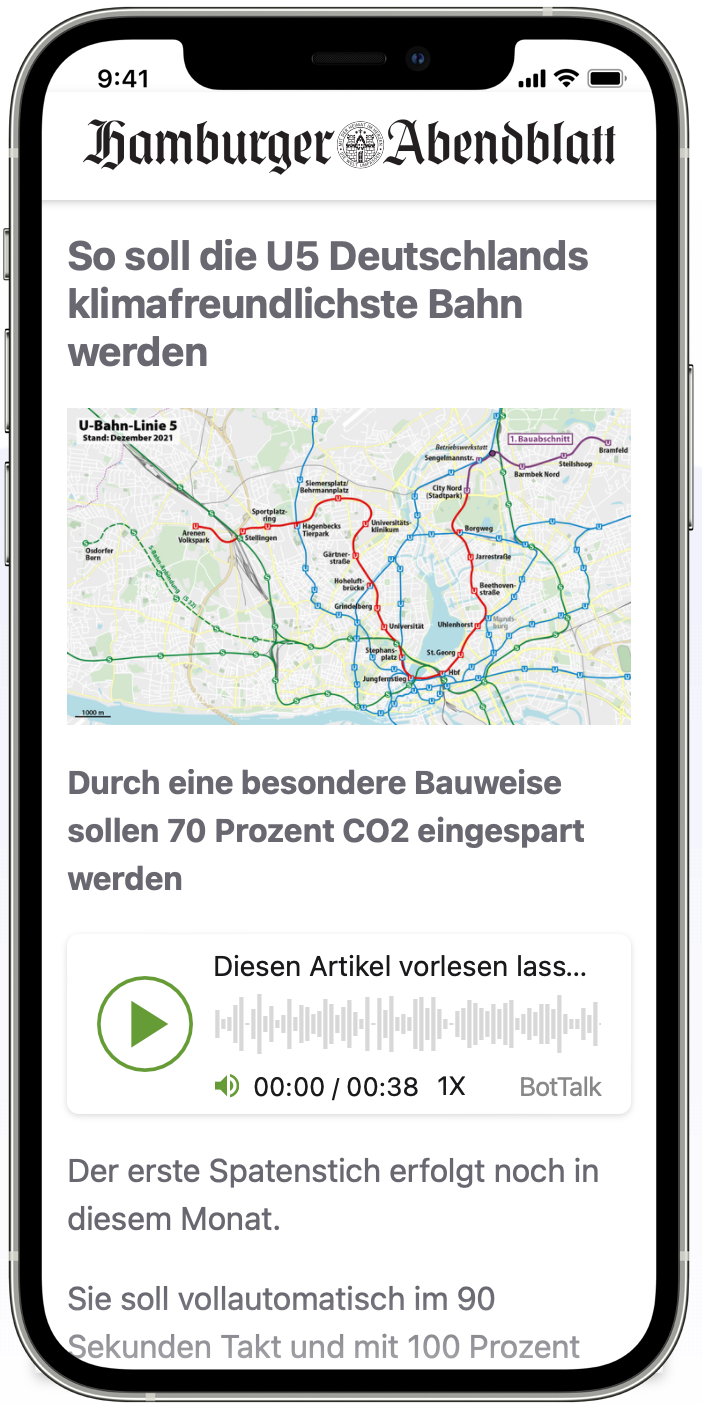Text-to-Speech 101: What Is TTS and Who Uses It?

Do you ever find yourself reading an article online and wish you could just have it read to you? Well, with text-to-speech (TTS) technology, now you can!
TTS is a type of speech synthesis that converts text into spoken words. This technology is becoming increasingly popular for a number of reasons, including its ability to help people with reading disabilities, its potential to improve engagement and comprehension, and its usefulness for language learning.
In this blog post, we'll give you a basic overview of TTS: what it is, how it works, and who uses it.
Table of Contents
- What is TTS, and how does it work?
- Who uses TTS, and for which purpose?
- The benefits of TTS technology in publishing.
- The History and Evolution of TTS Technology.
- How to get started with TTS technology?
What is TTS, and how does it work?
Text to speech (TTS) is an innovative technology that enables natural sounding voices to generate audible output from text. By using specialized software, natural human-like voices are generated by transforming text into speech.

This technology has the capability of understanding how words connect and interact with each other so that the audio output carries natural intonations and prosody, allowing listeners to perceive natural sounding speech.
Consequently, TTS has become increasingly relevant for news publishing business as it helps increase reader engagement and attracts new subscribers. The use of TTS also offers a great opportunity for monetization by incorporating audio advertising which can help grow revenue.
Science Behind the Natural Sounding Speech.
Text-to-speech technology has revolutionized the way speech is produced. By using speech software, natural sounding voices can be created with custom voice profiles based on speech text entered by the user.
The speech is then synthesized to produce a realistic and accurate facsimile of a human's vocal utterances. TTS systems use a combination of statistical modeling and deep learning algorithms, making them incredibly powerful tools for readers, broadcasters, game developers and more.
Additionally, many users take advantage of these technologies for accessibility purposes, increasing their ability to interact in the public sphere. Regardless of its usage, Text-to-speech technology has proven to be an impressive innovation indeed!
Linguistics Meets AI to Create Natural Sounding Voices with TTS.
Linguistics is the scientific study of language and is key to synthesizing coherent speech that sounds natural. To reach this goal, TTS systems need a well developed knowledge of linguistics that extends down to the phonetic level.
Additionally, it’s important for TTS systems to use appropriate prosody such as pauses, intonation, and stresses in order to enhance synthesized speech even further and make it sound most natural.
Audio signal processing is used for creating and manipulating digital representations of sound which are inputs for synthesizing synthesized speech.
Artificial Intelligence and Deep Neural Networks
Artificial intelligence, specifically deep learning, has unlocked a new wave of computing possibilities that allow machines to "think" more like humans. This type of machine learning relies on deep neural networks, which is a computational model based on the structure of the human brain.

Within these deep neural networks are processors that send data to each other in meaningful pathways. After being adequately trained to learn how best to process this information, deep neural networks able to accurately apply their knowledge and power with incredible efficiency.
This solution makes it the ideal candidate for text-to-speech conversions and any application requiring deep analysis of massive datasets in order to make an accurate prediction.
Who uses TTS, and what purpose natural sounding voice has?
TTS technology is used by businesses and organizations of all sizes, allowing them to create human-sounding audio versions of digital content. These human voices can be blended with a variety of custom voices, providing readers with an enhanced listening experience on any type of mobile device.
With TTS, there's no need to manually convert text into speech – the process happens instantaneously, converting text to audio content in near real-time. This makes it ideal for news publishing business as it helps engage readers while also boosting revenue through audio advertising opportunities.
Readers with no time or attention span to read
Reading content online can be a long and tedious process, and when you're busy, it may sometimes feel impossible. Luckily, text-to-speech (TTS) tools read aloud any article with an immersive audio experience that is close to natural speaking.

You don't need to sacrifice your daily activities to catch up on the news anymore - simply have TTS read the article for you while washing the dishes or driving in the car.
TTS can support multiple languages
Furthermore, with multilingual support for over 100 languages, no one is left out of this revolutionary experience!
According to leading experts in technology, we will soon see automatic conversion of all written content into spoken audio so that everyone can enjoy content on their own time.
Generation Z Loves Audio!
Young people of today readily embrace text to speech (TTS) technology in their daily lives, not because it’s strictly necessary for them – but because it’s convenient. Social media platforms such as Tik Tok and Instagram feature text to speech options.

Even if these young people don’t have a visual impairment requiring accessible text to speech technology, their preference may very well be using TTS anyway based on the reduced effort.
Attention Span
This is important to note because it suggests that Generation Z has a much different attention span than those who came before them; they prefer audio formats because they take less time and energy to register than audio inputs.
The benefits of using natural sounding voices TTS technology in Publishing.
TTS technology has revolutionized the news publishing business by giving synthetic voices the ability to bring text to life through speech. By utilizing high fidelity speech, readers can experience voices that sound more natural than ever before.
This creates a richer experience for readers and increases engagement, bringing the opportunity to win new subscribers and grow revenue with audio advertising.
TTS technology continues to bring synthetic voices into the mix of traditional news media outlets, allowing stories to be accessible on multiple platforms with an unparalleled level of clarity.
How does TTS Help Increase User Engagement?
In today’s digital age, text to speech technology has become a powerful tool to deliver the news in audio form on social media.

BotTalk’s statistics demonstrate that 10% of readers decide to listen to articles and over 75% stick till the end, which shows that text-to-audio can elevate readers’ attention span for digital content.
Moreover, young people are easily hooked onto this audio format as it provides them convenience and doesn’t require much effort or time. With text-to-speech, publishers get more subscribers and revenue from audio advertisements.
This innovative approach has become a critical aspect for the sustainable growth of news publishers, which goes beyond text formats due to its potential guarantee of positive engagement rate.
The History and Evolution of TTS Technology
Since the 18th century, scientists have attempted synthetic speech through mechanical means. Then in the 1930s, electrical methods made huge strides when Homer Dudley's Voder was introduced. However, it was not until 1968 that the first system to interpret text and convert it into intelligible English language speech was designed by Noriko Umeda and a team from the Electrotechnical Laboratory in Japan.
Formant Synthesis and Articulatory Synthesis
Early history of text to speech technology saw the implementation of various rule-based systems like formant synthesis and articulatory synthesis, which aimed to recreate natural human vocalization through manipulation of digitally synthesized audio signals.
These pioneers recorded speech from a speaker's voice and extracted their acoustic features such as intonation, manner of articulation, and formants - defining qualities in a person's speech - all for the purpose of programming rules that would capture these properties.
As promising as this method seemed, its capabilities were limited, missing the less pronounced nuances and subtle details between human conversations; these approaches simply lack the sophistication for considering and processing complexities like pitch variation or stresses.
Diphone Synthesis
TTS technology has come a long way since the 1970s, when researchers first developed what is now known as diphone synthesis.
Each diphone consists of a single-unit combination of phonemes and transitions between them – in other words, they represent not only the sound of a letter or syllable, but also half of the transition to the following sound. The total number of recorded diphones typically range from 3,000 to 5,000 and are then pieced together by computer algorithms to create a natural speech pattern.
As this technology continues to advance together with advances in natural language processing, it will become even easier for machines and AI programs to simulate human conversation in ways that have never been seen before.
Unit Selection Synthesis
As the history of text to speech (TTS) technology progressed into the 1990s, a new form of synthesis was taking center stage: unit selection synthesis. Unit selection synthesis began with the development of natural language processing and the realization that larger databases of recorded human speech could be manipulated for specific output.
This new method simplified production by removing the second processing step that had been present in diphone synthesis: now, selections from a library of 20 hours or more would be used to create natural sounding speech, sans additional sequencing.
Today, unit selection synthesis remains ideal for low-footprint TTS engines as it allows for rapid and efficient conversion from written language into spoken words.
Neural Synthesis
Deep neural networks have revolutionized text-to-speech (TTS) technology, allowing for custom voices to sound as natural and lifelike as human speech.
This state-of-the-art AI technology relies on input from text scripts and voice recordings to build its models. These deep neural networks can learn text sentiment, rhythms and intonations in order to reproduce a realistic copy of the original voices.
When text is fed into the trained model, it pairs the text with a series of acoustic features which are then processed by a vocoder, creating remarkably natural sounding vocalizations that could easily be mistaken for real human speech. With this level of accuracy and naturalism, advanced TTS technology is able to produce life-like synthesized voices.
How to get started with TTS technology?
TTS technology is an easy way to get started for news publishing businesses as it provides an innovative platform to engage readers in a variety of ways.
By leveraging speech software that produces synthetic, natural sounding voices, business owners have access to create customized content that resonates with their audience - no technical knowledge required.
From creating engaging audio articles to customizing the perfect voice for their brand, TTS technology offers powerful features to help increase reader engagement and gain new subscribers while growing revenue through audio advertising.
BotTalk Leverages Natural Sounding Text to Speech for News Publishers
BotTalk is revolutionizing text-to-speech technology by providing a state-of-the-art TTS platform that enables news publishers to automatically generate natural sounding audio articles out of their written text. Through the use of deep learning and artificial intelligence, this world class service allows for quick and simple integration with custom voice capabilities – so only one line of code is required for setup!

It's easy to add a paywall, audio advertising and measure performance; just another compelling example of how this fantastic AI platform is changing the way we interact with technology.
TTS Enables Audio Revolution for Publishers
In conclusion, TTS is a useful tool that can effectively take your content to the next level. From speeding up production time, to making digital devices more user-friendly, this technology has numerous benefits.
Companies such as media outlets and banks are already leveraging TTS for their own purposes, while educational platforms are also capitalizing on its potential. Plus, when you introduce audio into your content output it increases engagement among readers and furthermore helps win new subscribers who may be audio-based consumers. Moreover, if used correctly you could even further boost your revenue with audio advertising opportunities.
But, before implementing this technology into your workflow you have to have an understanding of how it works and where to start. You need the perfect balance between natural sounding text-to-speech capabilities across different languages and genuine human voices in order to make sure that customers feel like they're engaging with real people rather than automated machines. BotTalk provides all the tools necessary for success - not only for implementation but for ongoing analytics about your audience.
Innovation in business is key and with TTS technology now truly being within reach of many businesses, successful implementation can mean major wins in terms of productivity and revenue growth.
Future of Publishing Starts Today
The future of content is audio - so what are you waiting for?
Take action today – contact BotTalk for further information about integrating quality text-to-speech technology into your workflow!
